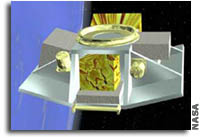UC Berkeley Satellite to Study Nearby Hot Gas

The first and possibly last of the cheaper-faster-better
university-class satellites funded by NASA in the 1990s is scheduled
for launch from Vandenberg Air Force Base in California on Dec. 19,
and will carry a single instrument built at the University of
California, Berkeley.
The Cosmic Hot Interstellar Plasma Spectrometer satellite, or
CHIPSat, will embark on a year-long mission to study the bubble of
hot gas that fills the space between nearby stars. This gas-filled
region, called the Local Bubble, is thought to be the glowing
aftermath of long-ago supernova explosions.
At a cost of $14.5 million, CHIPSat was built in three years by
engineers and students, led by research astronomer Mark Hurwitz, at
UC Berkeley’s Space Sciences Laboratory. With off-the-shelf parts
tested as the CHIPS instrument was built, Hurwitz’s team was able to
keep within budget and turn out a satellite that could operate far
past its scheduled lifetime.
“This is very much a low-cost mission,” said Hurwitz, who noted that
NASA is providing an additional $2 million for post-launch data
analysis and mission operations. “The reliability will be the best we
can make it for the cost.”
The data returned by the instrument will help scientists understand
our local region of the galaxy, as well as the origin and evolution
of the hot gas bubbles that riddle the galaxy.
“Like a neon lamp, which gives off certain spectral features that our
eye perceives as red, this much hotter gas in the interstellar medium
will give off special features that are deep in the ultraviolet
wavelengths,” Hurwitz said. “We are looking for that faint glow that
should be coming from more or less every point on the sky, that could
be attributable to this hot bubble of interstellar plasma.
“By seeing how bright the glow is and whether the spectrum really
matches what the models predict, we will be able to help understand
how long these hot bubbles live, because we will know more about how
quickly they cool.”
According to theoretical astrophysicist Chris McKee, professor and
chair of physics at UC Berkeley, the Local Bubble is about 300 light
years across, one of many regions of hot, low-density gas in the
galaxy. Though astronomers think these regions have been swept of gas
by the blasts of exploding supernovas and heated by the shock waves
from those explosions, no one is certain, since the supernova
remnants have faded into obscurity.
X-ray observations of the Local Bubble, and later extreme ultraviolet
observations by the UC Berkeley Extreme Ultraviolet Explorer
satellite, indicated the presence of gas at a temperature near a
million degrees – about the temperature of the sun’s atmosphere – but
the data were sparse. The CHIPS spectrometer will look at diffuse
extreme ultraviolet emissions from large areas of the sky, measuring
very precisely the intensity of specific wavelengths in the gas that
would indicate the temperature of the gas atoms and their state of
ionization, that is, whether they’ve gotten hot enough to lose some
of their electrons.
“CHIPS is going to have much higher resolution than previous
instruments and be able to measure the strength of individual lines,”
McKee said. “That would then tell us an awful lot more about the
physical condition in the hot gas.”
The data could tell astronomers how long ago the local supernova
explosions occurred – perhaps as long as 10 million years ago – and
how fast hot gas cools in the interstellar medium. It also could
provide information on the cooler cloud of gas hovering within
several light years of the sun.
“The sun is currently inside a local interstellar cloud, a wisp of
warm gas at about 7,000 degrees that is surrounded by the hot local
bubble,” said UC Berkeley research physicist John Vallerga, who is
looking forward to analyzing CHIPS data. “It’s not clear how this
wisp can exist in the hot local bubble, but with CHIPSat, we can
attempt to understand whether the warm local cloud in which our sun
resides is evaporating into the million degree gas.”
CHIPS was one of two low-cost UNiversity-class EXplorer (UNEX)
missions chosen by NASA in 1999 after a peer-reviewed competition.
One fell by the wayside, and the other, CHIPS, was bounced off
several satellites before it found a spot aboard a Boeing Delta II
rocket whose primary payload is ICESat – the Ice, Cloud, and land
Elevation Satellite. The rocket is scheduled for launch from
Vandenberg Air Force Base, Calif., on Thursday, Dec. 19, in the late
afternoon. Since it is piggybacking on ICESat, the larger satellite
will be launched first, then CHIPSat will be kicked into a nearly
polar orbit 380 miles (600 kilometers) above Earth.
“We are going to turn the satellite on slowly and carefully, so we
won’t be operating the science instrument until about a month after
launch,” Hurwitz said. “By six months, we should have some
interesting data.”
The approximately 190-pound (85-kilogram) micro-spacecraft is about
the size of a large suitcase, with most of the outer surface covered
by gold solar panels. The CHIPSat spacecraft was built by SpaceDev,
Inc., of Poway, Calif., while the CHIPS instrument itself was built
by engineers and students at UC Berkeley’s Space Sciences Laboratory.
“CHIPSat has trained along the way a lot of young engineers, several
at UC Berkeley and several at SpaceDev, as well as many undergraduate
students,” Hurwitz said. “It is rare that people in their 20s and 30s
get to be in charge of a major satellite subsystem – indeed, be in
charge of the whole
thing.”
NOTE: Mark Hurwitz will be at Vandenberg Air Force Base until the
Dec. 19 launch, but he can be reached via cell phone at (650)
868-3880 or at markh@ssl.berkeley.edu. During the launch, John
Vallerga may be reached at (510) 643-5666 or jvv@ssl.berkeley.edu.









